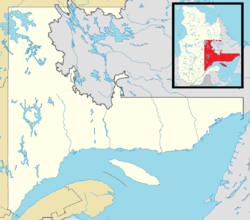Top Qs
Timeline
Chat
Perspective
Baie-Trinité
Village municipality in Quebec, Canada From Wikipedia, the free encyclopedia
Remove ads
Baie-Trinité (French pronunciation: [bɛ tʁinite]; Village Municipality) is part of the Manicouagan Regional County Municipality, in Côte-Nord region, Quebec province, Canada.
In addition to Baie-Trinité itself, the village municipality also includes the hamlet of Pointe-des-Monts, site of Pointe-des-Monts Lighthouse.[2][5]
Remove ads
Pointe-des-Monts Lighthouse
The Pointe-des-Monts Lighthouse,[1] a National historic site of Canada, was built in 1829–1830 on a point that ancient geographers, since Samuel de Champlain (1567-1655) himself, classified as the demarcation point between the St. Lawrence River and the Gulf of St. Lawrence.[6]
In 2023, all the facilities of the Pointe-des-Monts lighthouse include the lighthouse, the keeper's house and the footbridge. Over time, since its installation in 1830, several buildings have been demolished, as example, given the impressive number of shipwrecks at this time, a provision depot for shipwreck victims was built in 1831.[7][8]
- Pointe-des-Monts Lighthouse
- Information panel
- Information panel
- Keeper's house and outbuildings
- The keeper's house, the outbuildings, parking lot
- Interested visitor, stairs and artifacts
Remove ads
Toponymy

The village municipality are named after the small Trinity Bay into which the Trinity River drains. The river's name may be attributed to Jacques Cartier who sailed by this river on Trinity Sunday in 1536. The first permanent settlers came in 1840, the Baie-de-la-Trinité Mission was established in 1898.[9]
Geography
The municipality is located on the north shore of the Gulf of St. Lawrence at the mouth of the Trinity River (French: Rivière de la Trinité), a salmon river which flows through the village.[10]
The main access to the municipality is Route 138, also known as the Whale Route. The major economic sectors are forestry and fisheries.
- Gulf of St Lawrence
- From the top of the lighthouse Pointe des Monts[2] bedrock, gulf side
- From the top of the lighthouse, Pointe des Monts bedrock, estuary side
Ludger-Champagne rest area
The rest area belongs to the Ministère des Transports du Québec, it is located in Baie-Trinité, on the Route des Baleines, (Route 138), between Labrie and Jourdain streets, it recalls the memory of Ludger Champagne (1929-2020).
Mr. Champagne founded the Club 4 H of Baie-Trinité in 1966 and was an important player in the construction of the building that housed the 4-H relay, a rest area for the local population and travellers. The 4-H Clubs of Quebec, which brought together young people aged 8 to 18, were committed to the protection and conservation of the environment. The 4-H movement was created in 1912 in the United States and established in Quebec in 1942 by the Quebec Forestry Association.[11][12]
- Rest area Ludger-Champagne
- Beach, gulf of St Lawrence
- Route 138, picnic area, beach, gulf of St Lawrence
- Beach, gulf of St Lawrence
- Route 138, beach, gulf of St Lawrence
Remove ads
Demography
In the 2021 Census of Population conducted by Statistics Canada, Baie-Trinité had a population of 438 living in 231 of its 341 total private dwellings, a change of 7.6% from its 2016 population of 407. With a land area of 417.48 km2 (161.19 sq mi), it had a population density of 1.0/km2 (2.7/sq mi) in 2021.[4]
Mother tongue (2021):[4]
- English as first language: 1.1%
- French as first language: 94.3%
- English and French as first language: 0%
- Other as first language: 3.4%
Remove ads
References
External links
Wikiwand - on
Seamless Wikipedia browsing. On steroids.
Remove ads













